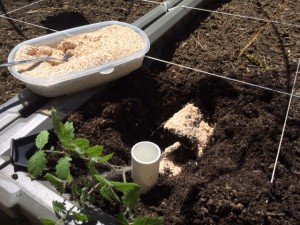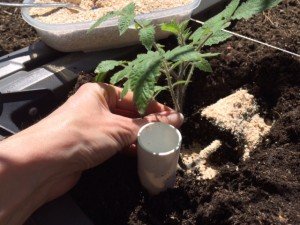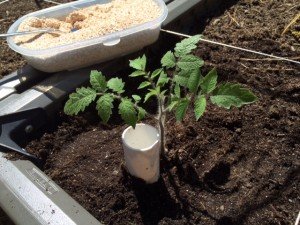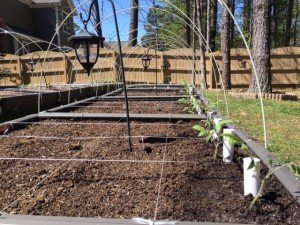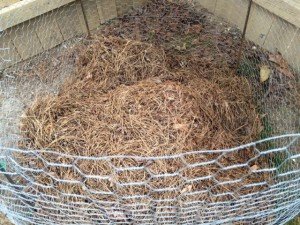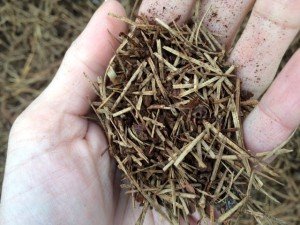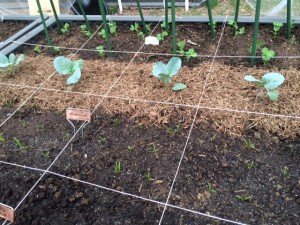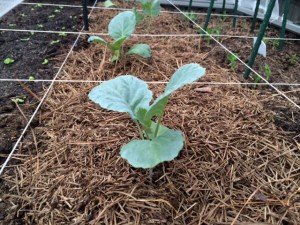Long Island is entering the 4th week of Work From Home orders during the pandemic and "home" has suddenly become the center of many people's lives in a way it has not been for a few generations.
I am looking out over the closest thing to my own Eden that I have ever found. One half acre of a southern facing backyard that backs to a canal of the Connetquot River. It was the productive capacity of this backyard as much as anything else that drew me to this home. From what I saw at the home and garden store yesterday, carefully socially distanced of course, many people are thinking about the productive capacities of their yards right now as well.
My first step in setting up my LI garden is starting a container garden for my herbs. The planters left by the previous owners added with my own should give me an full herb garden close to my back door. The containers a fairly large, but the first winter will be a test to see who overwinters and who does not.
Read MoreIt has rained all day, every day for a week now and the sky has run itself out of water! I stole this break in the rain to check on sown seeds and the herbs and berries.The back half of this box is mixed lettuces and the front left is daikon radishes. The front right is leftover bibb lettuce from a Victory Garden project at my son's school.The tomatoes and peppers are hardened off and ready to be planted in the beds. I have my own saved seed serranos as well as an heirloom yellow pepper this year and for tomatoes I am growing an heirloom grape tomato and trying my first F1 hybrid for a red slicing to improve yield.The blueberries are trying to live up to their names with a hint of purple starting to stand out against the green.The sage flowers have been a favorite of visiting bees but are ready for their spring pruning now.The chives are also sporting lovely dead head flowers and at last they seem to be truly established in my garden.Soggy but smiling!
Read MoreThe last frost date for this area passed without incident on April 9th and today was my first day home to survey the perennials and sow some annuals.I'm just going to say it, my over-wintered herb garden is just darned pretty this spring. And I am beside myself that the chives are not just alive but thriving! After years of refusing to grow for me, they are vigorous and even blooming.I was also ecstatic to see the blueberries bountifully in bloom!Last year the blueberries were conned into blooming by the false spring and a hard, late frost killed most of the flowers. A feeble second bloom happened after the last frost but didn't amount to much.The strawberries were also a pleasant surprise, not just sporting a healthy head of blooms but some hard green strawberries already just waiting for the warmth of the sun to make them blush.I threw caution to the wind a few weeks ago and mixed up the assorted lettuce seeds I had on hand and sowed them thickly in 1/2 of a bed. I love the mix of the reds, greens and the little ones already wearing speckles.And lastly I laid down 18 rows of spinach in the front 3/4ths of these beds that will also host 2 tomato plants each in a few weeks.Ahhhhh...the gardener's Spring has finally sprung!
Read MoreIt is the end of an unusually quiet summer here at NHG. A late, hard frost wiped out much of the spring plantings as well as this year's harvest of blueberries and asparagus. The figs and asparagus were late and modest. Only the herbs were undaunted by the hard freezes and have flourished their second year in their permanent bed. They have flowered and dropped seed which I hope will refresh the herb bed regularly by being able to remove the mother plants every year and allowing the next generation to take a turn.So today I began closing summer, deadheading the spent flowers and trimming back the herbs for drying.I also began the opening of fall today. Planting beds with radishes, spinach and cilantro then lightly recovering the seeds with the pine needle mulch that is a naturally occurring phenomena in my garden.Here's to a fruitful autumn!
Read MoreThe threat of winter weather pushed right up to the last frost date for my area this year. Add in my hectic schedule the past few weeks and the result is a late start on my spring garden, and some corners looking to be cut.These colorful lettuce varieties would normally be carefully planned and planted in their own distinct areas.This year I am deploying what I am calling a laissez-faire farming method of "mixed lettuces" saving a lot of time and proving that even lackadaisical farming sounds better in french.Seeding and watering these 9 square feet (around 100 plants) was the work of 5 minutes.I have to give a quick shout out to the oregano photo bombing the picture above (bottom and right of garden bed). This now feral oregano self seeded the area around it two years ago when I had the herb planted in this box. It is so thick and lovely year round that I am tempted to use it as a ground cover along paths.For the rest of my garden, this year I am doing a lot more grouping than normal, with all of a bed planted with spinach or radishes or edamame, allowing me to broadcast seeds and get everything started a little faster.Au revoir!
Read MoreAutumn has arrived in North Carolina, bringing with it the final harvest of bell peppers, roma tomatoes and serrano peppers.The herb garden has brushed off the first few light freezes and stands ready to make meals fragrant and savory for months to come. I am confident that the thyme, oregano and sage will over winter well and hope that the french tarragon and parsley will also.Parsley is such a staple of fall and winter dishes that I have more growing on my deck. I have been poaching from the deck parsley for a few weeks thinking that it would not handle the frosts as well, but so far it is also doing wonderfully.In previous years I have repeatedly removed pine needles from the garden beds only to replace it with a different mulch. This year I have come to my senses and am embracing the pine trees taking care of mulching for me.Collards, carrots, cabbage and parsnips are tucked into their naturally (and effortlessly) mulched beds.The fall planting of sugar snap peas has been supplying tender pea shoots and now has peas forming as well.The hydroponic herbs were changed over 10 days ago to the varieties I know and love to cook with and are already doing quite well. I am growing 2 plantings each of my favorite basils and cilantros, 3 of the flat leaf parsley and just for fun I am trying to grow 2 red kales hydroponically.With the Super Bowl and attendant tomato starts almost 2 months away, this cozy, fall garden that is mostly taking care of itself feels like a recess.
Read MoreDay 46 of the prepackaged herb pack that came with my AeroBount and I have excellent basil growth, both genovese and thai. The mint was just starting to grow and the cilantro, parsley and chives never really took off. The genovese basil, while in the same family, is not the basil I usually grow. I do not know if it is a function of the variety or of the hydroponics but it bruises extremely easy and blackens quickly on warm dishes.My Baker Creek order came in last week with seeds for my hydroponic herbs and counter top microgreens so I decided to ditch the prepackaged herbs and start my own this weekend.My aero garden has space for 9 pods so I planted 2 of each except for the parsley that I planted 3 pods of because fall stews + parsley = YUM!
Read MoreAlthough I have grown herbs indoors for each of the last 5 winters, my indoor garden has always been in a designated growing area and not particularly convenient to the kitchen. So in a kitchen that is already small on space, I gave over fully 1/2 of my breakfast bar to try the AeroGarden, because the idea of growing fresh, green herbs right where I cook this winter is very appealing. That probably also explains the microgreens taking up the other 1/2 of my breakfast bar now.Microgreens are a great choice for indoor veggies in the off seasons since they aren't usually around long enough for pests or disease to become a problem and can be used in a variety of dishes. They do need a little more attention in terms of keeping them moist and harvesting on time, but that is all the easier when they are located in the heart of a home.My breakfast bar has become a living pantry :)
Read MoreAs a cook (and human being) I am much more comfortable in the zone where I am critiquing past performance and looking for areas for improvement over standing on the precipice of something I have never tried. To that end, one of my favorite phrases is the French culinary phrase 'mise en place", which means "putting in place" and is a practice used in recipes that benefit from having all the ingredients measured and prepared before beginning.For my first ever adventure into home cheese making, mise en place was required...and possibly wine...Soft-cheese making is pretty straight forward (for the practiced) but with some specific temperatures serving as prompts to move to the next phase. Since this was my first go at it, that translated into me constantly monitoring temps so as not to pass or miss an important temperature window.With the first attempt at anything there are questions...are my curds curdy enough? Is the mesh in my strainer too large (or too small) that I have curds filling the holes?But then magic! I made cheese!!In the end, like any new recipe, it went mostly well with a decent and edible result. Then I begin the process of #Kaizen - constant, incremental improvement:
The cheese was a little firmer than most of the purchased mozzarellas I am familiar with - did I over work the curd?
The cheese was good, but a little on the salty side - I need to cut the salt in 1/2 for the next attempt.
My mozzarella was a little more yellow than the milky white mozzarellas I buy - is that related to the milk I purchased, something I did...I need to spend some time on google...
My favorite recipes rarely began as they are today and I am happy to add cheese-making to the list that is being constantly improved and refined until it reaches the point of second nature.
Read MoreMy Glass Gem Corn has been happily drying above my home office and today was the day to strip the cobs and put up the kernels for popcorn and next year's planting. If you have been following my blog for any amount of time you know that I have an abundant affection for this particular varietal which translates into an excess of photos...I stripped all the multi-color cobs leaving the two almost entirely blue cobs for last.Some of the kernels will be seed for next year and some will be popcorn, but in the meantime, they are still decorating my home office.
Read MoreLate blight is wrecking havoc on North Carolina tomatoes this year, particularly the heirloom varieties. Last year I was pulling down green tomatoes in late November and this year they were pretty much done by late August. C'est la vie.Luckily, there are some good things happening in the kitchen while I wait for the fall lettuce and spinach to fill in the garden. I have been working with my pasta maker, trying different shapers and getting the hang of the process. This week I wanted to try adding some fresh basil into the mix so I chopped it very finely and tossed 1 gram of it with the Anson Mills pasta flour before adding it to the maker using the angel hair shaper.The result was very pretty and did have a hint of basil taste. I was concerned that the basil would interfere with extruding and/or the pasta's ability to hold together when cooking, it did neither.I want to try the experiment again with a little more basil which means I should probably use the spaghetti shaper to be safe. I had already started the sauce when I decided to try adding basil to the pasta but next time I would like to try it with a simple butter garlic sauce that won't overpower the flavor of the pasta like the thick, homemade tomato sauce in the photo above.I am also wondering if I can do the same thing with finely chopped, fresh spinach and a thicker noodle.With fall/soup season just around the corner I have also ordered some kansui, the alkaline ingredient that gives ramen noodles their distinctive texture and the ability to hold up well in soups.I am beginning to suspect that the folks that sell fresh pasta and noodles at the Farmer's Market aren't doing it to make money, they just want an excuse to make more than they can personally eat...
Read MoreRecently I wanted to find some great make-ahead recipes that I could prepare in batches and freeze for fast and easy, but still homemade meals that I would feel good about on those "I don't feel like scratch cooking" nights. Stuffed pastas kept catching my eye as something highly versatile (options including but definitely not limited to: cheese, spinach, squash, beef, tuna with a bechamel sauce) and are super easy to freeze and reheat.I already had a great homemade pasta dough recipe (for use with the KitchenAid stand mixer and pasta roller attachment) and ravioli filling recipe but wanted to do some research and see if some varieties freeze better than others.While doing searches for freezing homemade stuffed pastas my results kept turning up all these recipes and ads for pasta maker machines...hmm. A few dozen YouTube videos and Amazon.com reviews later, I decided a pasta maker was just what I needed both to make fast and easy ravioli for my make-ahead meals as well as ditching the boxed, dried stuff in my pantry for fresh, on-demand pasta made with high quality wheat*.I found the pasta maker I wanted on sale at Williams-Sonoma - the Philips Smart Pasta Maker. I liked this one in particular because in addition to the weighing function which helps you fine-tune your liquids if you are using more or less than a perfect single or double batch of pasta flour, it comes with 8 shaping discs meaning no accessories to purchase later.I had to try it right away after it arrived so I made a simple angel hair pasta to get a feel for the machine and process.The adverts say that you will have fresh pasta in 15 minutes, I am pretty sure they mean when the last of the noodles come out because this machine begins extruding pasta in just 3 minutes!I made a double batch which was double the amount I needed. The other 1/2 can be dusted with flour and refrigerated for a few days or frozen for a longer storage time.The pasta was fantastic - delicious and with great bite, perfect al dente!* A note on the pasta flour I use - as much as possible, I buy my grains from Anson Mills. I could do a whole series of posts on Anson Mills and founder Glenn Roberts and how they are reviving lost tastes through heirloom grains. If you haven't read it yet, a great way to get to know Glenn is through Dan Barber's seminal book The Third Plate. I became an instant convert based on what I knew about Glenn's grains. Tasting them only further cemented my ardor.
Read MoreThe Glass Gem Corn is winding down and I will have a couple more ears to harvest over the next few weeks but today was really the big finale with 4 ears harvested and two that were almost* entirely in the blue spectrum.I plan to make some popcorn from this year's harvest, but also plan to double my planting for year's crop from saved seed. This is a exponential goal/reward because for every one corn plant I plant two black eyed pea plants to nourish the corn and climb the stalk for support and I am enjoying the still growing store of homegrown black eyed peas to cook up for good luck on New Year Day and would like to have even more for New Years 2018.*the bottom right cob has a single green kernel that only makes the rest of the cob look all the more blue.
Read MoreI had my largest one-day harvest of Roma Tomatoes at a little over 3.5 lbs, a similar weight in Amana Orange and Mortgage Lifter Tomatoes were ready to be picked along with some cherry tomatoes, a nice bowl of figs, more black eyed peas to add to the jar and four more cobs of Glass Gem corn.I can't get over how pretty and varied the glass gem cobs are, each seems to have their own color theme.I have at least 5 more cobs to harvest and I can't wait to see their variations!
Read MoreUnder the best of circumstances July is an awkward time for the garden.Spring greens (spinach, lettuce, cilantro) still in the garden have bolted or browned, strawberries have stopped producing anything but dozens of straggly runners and asparagus has transmogrified into its less known, fuzzy small tree form. Between these only-a-mother-could-love-them beauties are the bare spaces where sugar and snow peas and pak choy have been removed but it is still too early to sow fall plants, July may be the worst time to have a garden guest.I have a garden guest coming next week.The wonderful REALTOR that patiently waited and watched while I stood in potential back yards mentally calculating full sun hours and painstakingly measuring for raised beds that were at the time, stored in a rented garage, is coming to see what I "have done with the place" and late July is the date we picked for dinner and a garden tour.This post is half garden update, half convincing myself that there are still beautiful things to be seen even in this straggly season. Here goes:The blackberries are huge and I should still have a good mix of ripe and unripe next week.I always overseed plants like basil so I can use the thinnings on meals while letting the main plants mature.There is only one butternut squash on the vine so far, but many blooms.I picked my first round of Envy edamame with only a handful left in the garden, but I had left the wonderful nitrogen fixing plants in the garden as companion plantings to everyone else.And the rest of this story is tomatoes, the beauties of summer. These are some of the Blue Cream Berries cherry tomatoes before they ripen and take on that creamy yellow color.The roma tomatoes are thick on the vine and ripening at a steady rate.A pretty average harvest day with a double handful of roma tomatoes, a couple of Mortgage Lifters, a bowlful of Hartman's Yellow Gooseberry cherry tomatoes (the most prolific and tallest of my cherry tomato plants this year) and my first Black Beauty zucchini of the year.Here's hoping she really likes tomatoes ;)
Read MoreWhen was the last time you ate a tomato and considered the intrigue and controversy surrounding it's provenance?This big guy, sold by Baker Creek under the name Mortgage Lifter is almost ready to harvest and when I save the seeds after enjoying my first taste of this storied heirloom fruit, I will be thinking of the dueling stories of where it originated. A little food for thought ;)
Read MoreThe view standing next to my Hartman's Yellow Gooseberry Tomato.The view a few steps back. This tomato plant has already over taken the 8 foot bamboo support pole and I need a step ladder to access the top with many months of growing still ahead. Watch out Charles Wilbur...
Read More
















